We stayed in Worcester last night, our B&B, Burgage House, a biscuit’s toss from the cathedral, which is lit at night and towers eternal and somehow comforting above everything.
I’m almost over my jet lag but woke up early and by about 7 a.m. I decided to give up trying to go back to sleep and do something constructive, so I went for a run along the river – beautiful – the leaves of the trees on the banks all orange and gold, and many swans a-swimming on the water.
I did some more reading last night on the Battle of Worcester and spent much of today trying to fit the landscape of today with what happened 359 years ago. So as I ran past the old church tower referred to as the Glover’s Needle and down to the river, I knew I was passing over the ground where thousands of Charles’s Scottish troops made their last stand and finally surrendered when they knew the battle was lost.
I went into the cathedral for a few minutes, having learned since our visit yesterday that many of those Scots were herded into the cathedral after the battle. I can only imagine – they must have been exhausted, hungry, in utter despair. They knew whatever faced them could not be good, and they were right. Many were sent to work in virtual slavery in the West Indies and some were even sent to the American Colonies, a voyage about equivalent with being sent to the moon today, I think, in terms of hoping to return home. And many of them were wounded, with no hope of real help.
I told our landlady about the Cromwell trooper ghost at the Admiral Rodney, and she said that there have been occasional sightings of an old lady and/or child in white nightgown at Burgage House. Not surprising. It seems it would be hard to find a place around here that isn’t haunted, there is so much history.
Yesterday we had managed to see quite a lot of the ancient center of the city, and today we made a visit to the Commandery, a medieval half-timbered house that Charles used as his headquarters in the run up to and during the Battle of Worcester. This is a really spectacular place, and run as a very interesting museum. When you enter, you are given a device with an audio tour on it – common enough. But as you walk through the building, in each of the 35 rooms or sites you can select which of six different periods when the building was used for six very different things you want to hear about. I chose to listen to the information about 1651, of course, but could also have heard about the building’s use as a monastic hospital in 1480, by merchants in 1607, a private home in 1764, a college for the blind in the 19th century, or a printworks in 1952. Many of the rooms are not furnished at all, but some have themes – the communication room, the writing room, clothing, etc. -- and has representative items from each of the six periods.
Much of the building is as it would have been during Charles’s time, with the original beamed ceilings, half-timbered walls, and wide plank floors, and with the very well written and acted audio with sound effects – a young man inviting us to accompany him through the house and telling us about what would have been happening in and around the house – the troops camped on the ground, the discussions of strategy, surgery on the wounded, General Hamilton dying after being hit by a cannonball, the panic when the Parliamentary troops took control of Fort Royal on the hill above and turned the guns on the town.
Then we walked up Wyld Street to the site of Fort Royal, a medieval fortification that had been built up earlier during the Civil War and was hastily and incompletely further fortified with ditches and earthen ramparts as it became clear Worcester would be the site of the showdown between the Royalist and Parliamentary troops. There is no trace remaining of the star-shaped fort, and the hill is now a peaceful park with a panoramic view of the city, but a chevron shaped flower bed marks the spot of one of the artillery bastions, where at about 5 p.m. on September 3, 1651, the Essex militia swept down from above and massacred the defenders of the fort.
According to Worcester, 1651 by Malcolm Atkin, “This was the moment at which Cromwell decided to change the plan of battle and launch an all-out attack on the city,” and that flower bed marks the point of some of the most bitter fighting of the battle. Having captured the fort, the Parliamentary cavalry charged the town gates. Charles’s Scottish troops attempted to retreat within the city walls, but met a logjam at Sidbury Gate. Only scraps of the city walls survive, and none of the city gates except the massive Edgar Gate, near the cathedral, which gives a good idea of how the tide of the battle turned when Cromwell’s men broached the gates and entered the city. According to Atkin, “The final Royalist counter-attack was probably along High Street as the King’s English supporters mounted a last desperate charge to cover his escape as dragoons closed in on the royal quarters.” Only about 3000 of Charles’s men were English – the rest were Scots, who the English regarded pretty much as savages, which may be one reason more of them didn't join the Royalist march to Worcester.
Charles’s quarters, on New Street near Cornmarket, survive, in a Tudor building that now houses the King Charles Restaurant, where we had a lovely dinner last night. It was from that house that Charles is supposed to have escaped by the back door as Cromwell’s troops were entering at the front door at about 6 p.m., barely getting out St. Martin’s Gate directly behind, and beginning his six-week flight.
Charles fought valiantly and tirelessly, according to contemporary witnesses, and fled only when it was clear that his troops were routed and the best thing he could do for the future of the monarchy was to avoid being captured.
The center of the city, along the narrow Friar Street and New Street, still has many medieval and Tudor buildings, and it’s not hard to imagine how it would have looked in 1651. At the time, the city had a population of only 7,000, and was completed enclosed within the walls. It must have created an enormous strain on the city when about 13,000 Royalist troops descended on it in mid-August 1651, and having to deal with the 2000 to 3000 dead and 8000 or 10,000 captured soldiers after the battle must have been beyond belief.
Leaving Worcester, we drove north along the route that Charles took during the night of September 3, and made our way to Mosely Old Hall in Staffordshire, where Charles spent the night of September 8, 1651, after several hellish days bouncing around between other houses in the area. I drove once we got out of the city. I’m getting a lot more comfortable with the driving here, except for roundabouts, of which there are many, and we had a hair-raising moment on one of them this afternoon.
At Mosely Old Hall, guide Pam Jones gave an excellent and informative tour of the house, and later gave me a more detailed account of one incident, both for the facts and so I could record her charming local accent.
Although the original Tudor half-timbered exterior of the house was bricked over during the 19th century, the interior remains largely as it would have been during Charles’s stay. Taking pictures inside the house isn’t permitted, but fortunately I took a lot of photos at the Commandery which has similar architectural features.
I really hardly know how to say how exciting and moving it was to be in the actual house in which Charles spent one of his most dangerous nights -- and also in a house which Jane Lane wold surely have known, as it was only a couple of miles from her own. After the tour was over, I took the opportunity to walk through the house again. It was the end of the day, and I had the place completely to myself. There was the very three-paneled door decorated with nail heads which Charles described to Samuel Pepys in 1680. There was the very window out of which he watched the remnants of his Scottish infantry limping their way homeward, spurned by the locals and starving. There was the bed in which he got a few hours of sleep – the first time he’d been in a bed in 5 days. And most amazing of all, there was the priest hole where he spent the night.
Because Catholicism had been outlawed in England after the death of the hated Mary Tudor, many Catholic or “Recusant” families built into their houses small secret cubbyholes in which they could hide a priest, or even religious objects or texts. Mosely Old Hall has three of them. The one in which Charles spent the night is a space about four feet by five feet, and about four feet high, with brick walls. It is reached through a trap door in a small closet off of a bedroom on the second (or first) floor. The closet likely served as a garderobe, or toilet.
Charles was 6’2”, and wouldn’t have been able to lie at full length in the priest hole, but he was safe. Or so he thought. The next afternoon, Roundhead troops arrived to search for the fugitive king. Mr. Whitgreaves, the owner of the house, had heard they were coming and had opened all the doors and windows, to show he had nothing to hide. The troops accused him of having been at the battle. He denied it, and the gathering crowd of neighbors backed him up. While this confrontation was going on, one of the troopers went around to the back of the house, where a blacksmith was at work shoeing the family’s horses. He told the blacksmith that if he disclosed where the King was, he would get a reward of 1000 pounds. The blacksmith said he knew nothing, and so careful had the Whitgreaves family been, he probably didn’t. Finally, faced with a defiantly peaceful old man and his friends, the troops left. But Charles knew that every minute he stayed his situation became more dangerous, and late the next night he was moved a couple of miles away to Jane Lane’s house, Bentley Hall, and in the morning at dawn they set out on their journey.
I was really thrilled to see a portrait of Jane at Mosely Old Hall. The only portrait I’ve seen of her (aside from some fanciful representations) was done much later, and this portrait shows her much younger, prettier, and more vibrant.
Finally tonight, a drive of 20 or so miles to Leys House in Gnosall, where we’re staying for two nights. A warm welcome, with a pot of tea and homemade jam cake. It’s way out in the country – a black sky full of stars, and the air heavy with the scent of manure from the surrounding farms. Much of this area is still very rural, and throughout our travels today, it was wonderful to take in the red earth, the stubbled fields, the rolling hills, and the colors of the autumn leaves, knowing that Charles and Jane, traveling only a few weeks earlier in the year, would have seen much the same thing.
Dinner tonight at a lovely pub called The Boat, right on the branch of the Shropshire Union Canal that runs through the country here. A few pounds of lamb in a lake of mint and redcurrant gravy, with an enormous baked potato and a plate of vegetables, as well as two pints of Marston’s bitter. I only managed about half of it, but dinner has been like this every night, and I’ve had bacon and eggs for breakfast every day since I got here. It’s got to stop!
Wednesday, October 28, 2009
Subscribe to:
Post Comments (Atom)

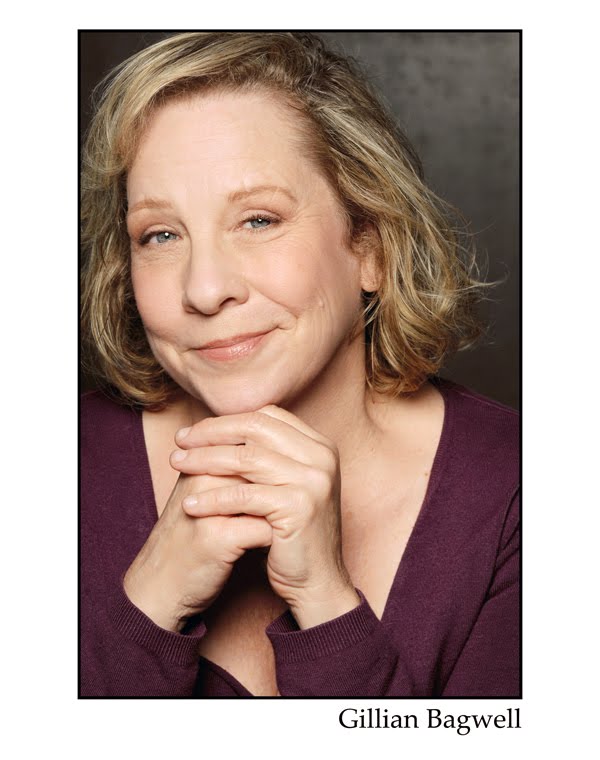
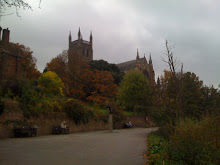
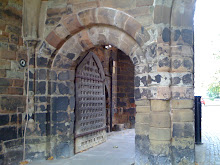



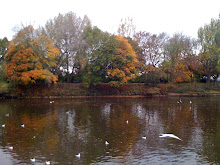
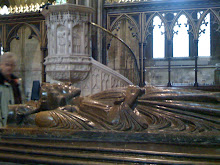
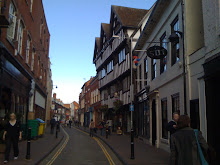


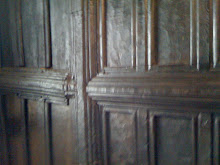






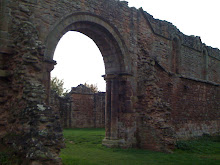




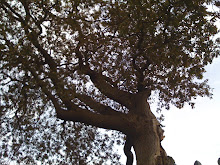





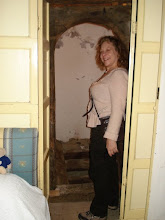
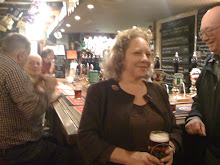
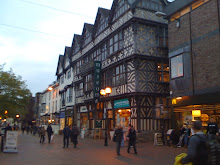
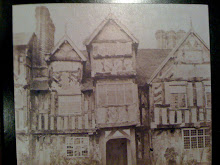


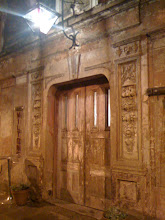
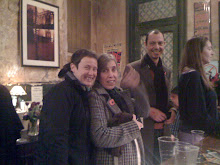


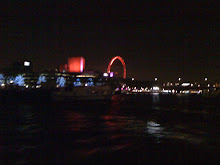


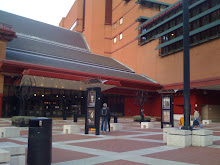






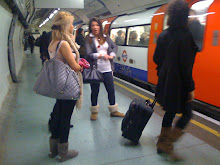

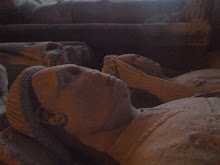
No comments:
Post a Comment